Personal Report of
ETRIA TFC 2016
Introductions to Individual Papers:
Jun. 7, 2017 (in English)
Personal Report of
ETRIA TFC 2016 |
|
| F. Patent Studies (1 Paper) | |
| Toru Nakagawa (Osaka Gakuin Univ., Japan), Jun. 7, 2017 (in English) |
|
| Posted on Jun. 21, 2017 |
For going to Japanese pages, press buttons.
Editor's Note (Toru Nakagawa, Jun. 7, 2017)
This is a part of my 'Personal Report of ETRIA TFC 2016', whose parent page
was posted on Feb. 14, 2017. The Section (5) Introductions to Papers is going to be posted in 7 HTML pages, categorized with their topics for easier access.
A. Methodology of TRIZ
(Mar. 30, 2017)
B. Integral Use of TRIZ with Relevant Methods(Mar. 30, 2017)
C. Case Studies in Industries(Apr. 24, 2017)
D. Promotion of TRIZ in Industries(Jun. 4. 2017)
E. Usage of TRIZ in Education and in Academia(Jun. 4, 2017)
F. Patent Studies(the present page) (Jun. 21, 2017)
G. Applications to Soft & Non-technical Areas(Jun 21; Jul. 18, 2017)
Editor's Note (Toru Nakagawa, Jun. 7, 2017) All the figures are shown here from the Authors' slides under the Authors' permissions.
F. Patent Studies ![]() marks are highly recommended.
marks are highly recommended.
No. Title
Author(s)
Introduction F1
Enhancing Patent Portfolio Using TRIZ Workshops Frank Zeihsel, Christian M. Thurnes, Jan Schulze (Germany)
F. Patent Studies
F1. Enhancing Patent Portfolio Using TRIZ Workshops
Frank Zeihsel (Synnovating GmbH, Germany), Christian M. Thurnes (Univ. of Applied Sciences Kaiserslautern, Germany), Jan Schulze (Thyssenkrupp Intellectual Property GmbH, Germany) ![]()
Abstract written by the Authors is cited here first:
This article will show on an industrial case how TRIZ is used to strengthen and enhance the patent portfolio of companies. Therefor a special workshop setting is created. Resulting from typical boundaries within companies the preparation as well as the execution of the workshops that can be divided into problem solving and patent enhancement sections are described in this article. In addition a summary of the workshop results is presented.
This is a nice case study paper where we can learn how the one-day workshops for solving problems and enhancing patents with TRIZ are organized and carried out. The workshops mostly use the method and software developed by Ideation International Inc. (USA). The method and the software (IWB) are described well in a compact and yet understandable manner, without focusing on concrete problems.
The slide (right) shows the motivation why the Workshops were started at thyssenkrupp corp., a German multinational conglomerate and one of the world's largest steel producers. The company invited TRIZ experts, the Authors, as facilitators of the Workshops for enhancing patent portfolio and innovative problem solving. In these 2 years, 20 times of one-day workshops were carried out in a standardized way as described here. The Workshops are held as mini projects of handling specific problems.
The mini-projects were carried out as Workshops for only one day (see slide (below left)), because Subject Matter Experts (SMEs) are spread over different locations. The paper writes: "The Team in a Workshop should not exceed 10 persons including the facilitator. Best is five to six Subject Matter Experts (people open minded for innovation from other departments or business units are also welcome) and one or two members of the patent department (patent engineer or patent attorney)." The slide (below right) shows the necessity to define the business areas for enhancing the patent portfolio of the company and to find out a specific problem or need for handling in a workshop. The slide also mentions some criteria for selecting a topic in the Workshop.
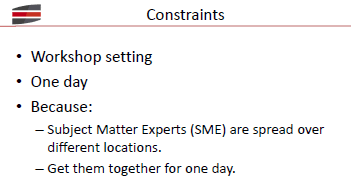
The slide (right) shows the timeline of the Workshops. Holding a Workshop on a certain topic with certain selected members must be decided beforehand of the events expressed in this time line. Then the Team members (most likely Subject Matter Experts) must fill in Innovation Situation Questionnaire (ISQ), 2 weeks before the Workshop. In two weeks the Facilitator prepares for the Workshop by understanding the ISQ and building a model of the problem (in Problem Formulator Model). Then the Workshop is carried out on a single day (for 8 - 9 hours). In 2 days after the WS, the process and results of the WS are documented fully.
*** This standard timeline is a good practice to clarify the cooperative roles of the people involved.
The first stage of the WS timeline is to fill in Innovation Situation Questionnaire (ISQ) (See Slide (below left)). ISQ is filled by the Team members to collect and structure the information about the problem situation. Details of ISQ can be seen in the book "Systematic Innovation: An Introduction to TRIZ" by J. Terninko, B. Zlotin, A. Zusman (1998). Then at the 2nd stage of 'WS Preparation', the Facilitator works on the basis of the ISQ to understand the problem situation better by collecting additional information. Articles, publications, Web searches, brief patent surveys, etc. may be used. On the basis of such enhanced understanding, the Facilitator also draws a model of problem situation in the form of Problem Formulation Model.
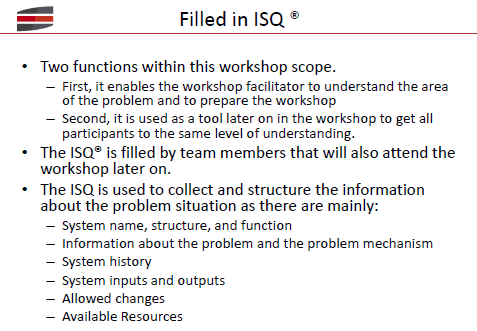
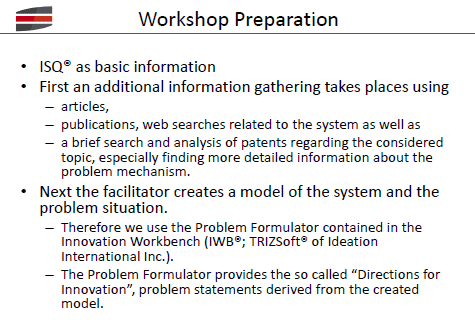
The slide (right) shows an example of Problem Formulator Model. The IWB software has the function to draw this type of model easily and to use it later for suggesting various possible ways of solving the problem.
Problem situations are expressed here in the form of Cause-Effect relationships. Green rectangles stand for useful events, while Red rounded rectangles harmful events. Green Arrows represent causal relationships resulting useful events, while Red Arrows resulting harmful events. The Green Arrow with + mark means a preventing action against a harmful event. Yellow rectangles represent 'Contradictions', which cause both useful and harmful events.
The particular case shown here is the problem being made by the parts falling from a conveyer into a small container. Drawing the Model like this may be difficult for beginners but not so much for experts by use of ISQ description in sentences.
The slide (below) shows the structure of the one-day Workshop. Circles represent the steps to follow. Goal of the workshop is to create as many ideas as possible for new patents. So the Authors writes: "To support this, the participants are requested to document their ideas immediately by writing them on a big post-it or similar, present it to the other participants by reading it loud and explaining it, and put it to the so called 'Idea Pool', a brown paper board placed in the room so everyone can see the ideas. Furthermore the facilitator documents every idea in a software tool."
The 1st step is to discuss and complete ISQ. Q&A and discussions are useful to bring all WS participants to the same level of understanding of the problem. Then at the 2nd step, the Problem Formulation Model is discussed and completed. The model representation in the cause-effect relationships is usually easily understood by the participants.
At the 3rd step, the participants are guided to think of further new ideas from various viewpoints. This step is particularly supported fully by the IWB software. The software can analyze the Problem Formulator Model to suggest a large number of 'Directions for Innovation'. Working with the Directions for Innovation has 3 types of tasks, namely, Solving Contradictions, Eliminating Harmful Functions, and Improving Useful Functions. For each type, the software guides the users with different, appropriate displays, as shown below.
The slide (below) is the software guidance for Solving Contradictions. Item 1 in the left column suggests to 'Find an alternative way to obtain' the contradictory function (in this case: 'Falling parts from conveyer'). Item 2 suggests to 'Resolve the contradiction' (in this case: 'Falling parts from conveyer') so as to provide the useful function and not to provide the harmful function. For solving contradictions, various Separation Principles are suggested to use, as shown in the middle part of the left column and also in some more concrete form in the right column. At the bottom in the left column, two ideas generated in response to these suggestions are documented (by the Facilitator) in short sentences.
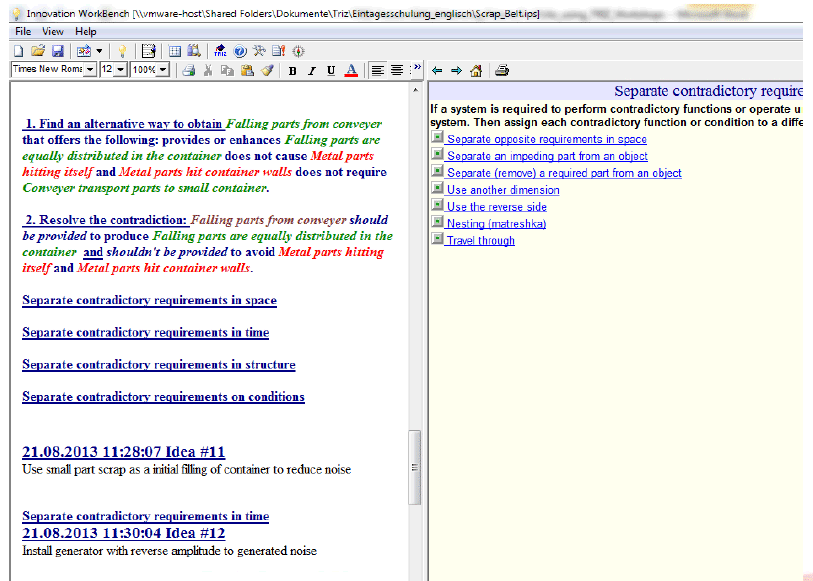
Next slide (below) is another software guidance in the cases of Eliminating Harmful functions and Enhancing Useful functions. In Item 3 in the left column, the software suggests a 'Direction for Innovation', by saying: 'Find a way to eliminate, reduce,or prevent' a harmful function (in this case: 'Metal parts generate sound'). The software suggests possible alternative directions of solutions at the bottom half in the left column. The first of the suggestions is 'Lower harmful parameters' of the harmful function. When we click it, the software shows a list of whole parametersrequests (in the right column) and requests us to choose (one or multiple) appropriate parameters. When we select some parameters, the software will further show various concrete ways of reducing the parameters, explaining (scientific and technical) principles and further examples (if we desire). There are some more suggestions shown in the bottom half of the left column for reducing (in a general sense) the harmful function. All these suggestions form a part of 'System Operators' developed by the TRIZ experts of Ideation International and installed in their software IWB.
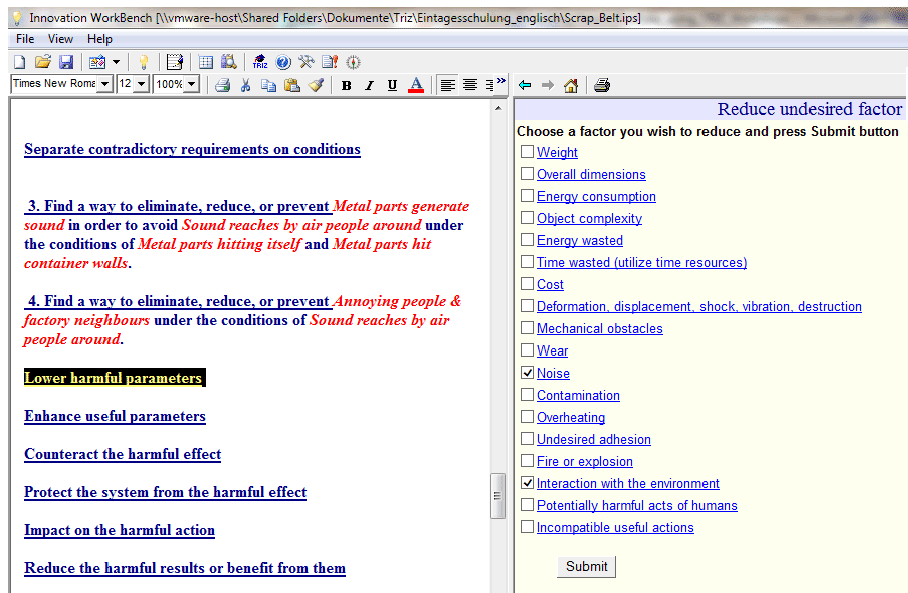
As demonstrated above, a large number of ideas can be generated in the discussions guided by the 'Directions for Innovation' and subsequent software suggestions. If we have many and different approaches of ideas, it is useful to cluster the ideas and enhance the ideas at this stage, as an optional step (see slide (below left)). Then at the final step of WS, all the ideas are individually evaluated with two-dimensional criteria (see slide (below right)). The y-axis is 'Expected use/Potential', while the x-axis 'Effort'. Ideas with High Expected use/Potential and Low Efforts are desirable, of course.
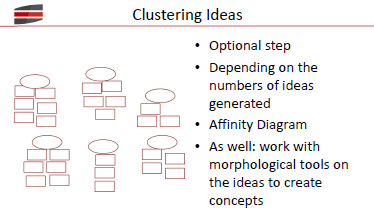
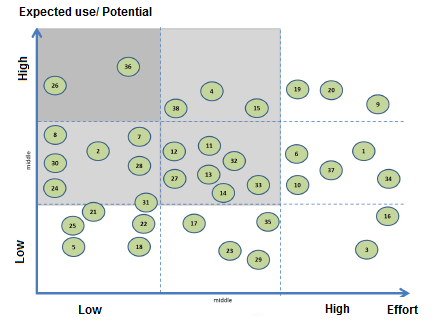
After the one-day Workshop, a full document of the results and process of the Workshop is prepared in 2 days and reported. Since all records of ISQ, Problem Situation Model, Directions for Innovation, generated ideas, evaluation, etc. are made and revised in the software during WS preparation and WS itself, the Documents can be made by the Facilitator smoothly.
The Conclusion slide (right) summarizes the results of carrying out this type of Workshops in thyssenkrupp corporation. The Authors have conducted 20 Workshops within the last 2 years in different business units at thyssenkruppe. In average 30-40 ideas are produced during the WS and about 4-5 patents are created after WS.
*** This is a nice report of conducting standardized problem solving mini-projects, in the form of one-day Workshop as the core having its preparation and documentation processes. The whole process is guided by the methods and software support developed by Ideation International Inc. The method and software have been existing for these 2 decades, but have not been opened much as proprietary of the consultant company. In the present paper we can learn much the methods and effectiveness of the software support.
I feel, however, somewhat not convinced much in working with the Cause-Effect model (or Problem Situation Model) and the software supported 'Directions for Innovation'. They basically represented by sentences; especially the sentences of 'Directions for Innovation' (probably nearly 100 directions are generated from the Problem Situation Model having 18 nodes in the above example) are difficult for me to read and think. They try to be rigorous and exhaustive, and hence too much for me. I would rather like to think with a rough sketch of the problem situation, where parts are falling from the conveyer into a pile of them in a container making much noise. Such a sketch can show the mechanisms of the problem and implicitly the failure in the system mechanism. Thus we can discuss a lot about the intentions (or requirements) and weak points of the original design and about alternative and improved ways of new designs. We can discuss the core contradiction of the problem in a more straight and concentrated manner. (Probably in the Workshops people are using various sketches of the original and new designs, I guess. Since such an aspect is not shown in the present paper at all, I dare to mention this comment.)
I recall a TRIZCON2001 presentation by Dana Clarke and Boris Zlotin (Ideation International): "The Art of Inventing Failures: Fuel Tank Rotation Case Study (Navistar)". The paper drew the Problem Formulation Model and had generated many ideas (just as in the present WS paper). In my Personal Report of TRIZCON2001 (in English)
, I wrote my feeling that the cause effect model (and a sketch of fuel tank rotation) miss in focusing the physical mechanism in the instantaneous moment of fuel tank rotation due to a shock of the truck from road, and I showed a simple and better (I believe) solution idea.
In ETRIA TFC2016, a number of papers used RCA+ diagrams. RCA+ diagrams and Problem Situation Model both represent Cause-Effect Chain relationships, using mostly the same conventions. The former seems focused in representing the mechanisms of Root Causes, while the latter seems to intend to describe the problem situation somewhat more relaxed way.
Last updated on Jul. 18, 2017. Access point: Editor: nakagawa@ogu.ac.jp